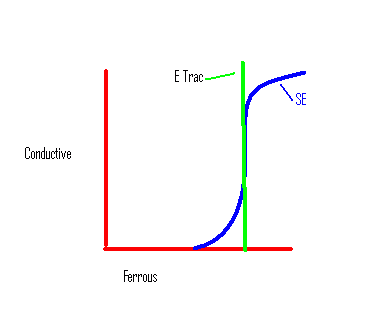I don't know about the customer service issue. I know the service is available in the US and I have heard people say that they have not had any problems, but I have not had a need to use the customer service so I have no first-hand experience there.
The Pro coil is the way to go. It's an incredible coil. It comes standard on the E-Trac and is on the later versions of the SE (the SE Pro). If you get an SE, make sure it's the Pro version, in my opinion.
As for how the SE varies from the E-Trac... it is a different beast. Basically what they did with the E-Trac was to increase the variation between 'good' target signals.
Targets are measured on the Exporer Series machines and the E-Trac using a combination of two numbers: Ferrous (the ferrous content of the target) and Conductive (the conductiveness of the target). In general, targets with high conductive numbers are 'good' targets (i.e. silver). Gold is an exception, as it comes in lower (bottom/middle).
On the SE, the Ferrous/Conductive curve graph is 'S' shaped -- which just basically means that at the top and bottom of the graph (ie at very low and very high conductive values), there is very little difference between good targets. See my graph below:
The blue curve is the SE. You can see that at the bottom area of the curve (where gold tends to fall) and at the top of the curve (where silver falls) there is not a lot of variation between targets in the Conductive value, while there is a good deal more variation in the Ferrous value. This is why a lot of SE users (myself included) preferred to use Ferrous sounds on this machine -- meaning that the machine gives a tone based on the ferrous content of the target instead of on the conductive content as most machines do.
So to summarize, identification of the targets at the very top or bottom of the curve (where most people look for good targets) is determined mostly by the Ferrous content of the target. Versus the middle portion, where it is determined mostly by the Conductive content.
But on the E-Trac, they re-engineered things so that the S-shaped curve turned into a vertical line (green line on graph). The goal was to make the variation between the desirable targets to be projected onto the Conductive scale with very little variation on the Ferrous scale.
Therefore, the Conductive target IDs are much more stable and accurate on the E-Trac than on the SE. Good targets on the E-Trac have a ferrous number at, or very close to, 12.
There are other things that were improved also, including an issue with the Iron mask somewhat related to what I described above, where good targets on the SE were being cut off when Iron Mask was employed.
So E-Trac is really not just an improved Explorer, but it's a completely different machine. Hope this helps somewhat.
edit: By the way, this info came from Andy Sabisch's book, which is well worth the read.
